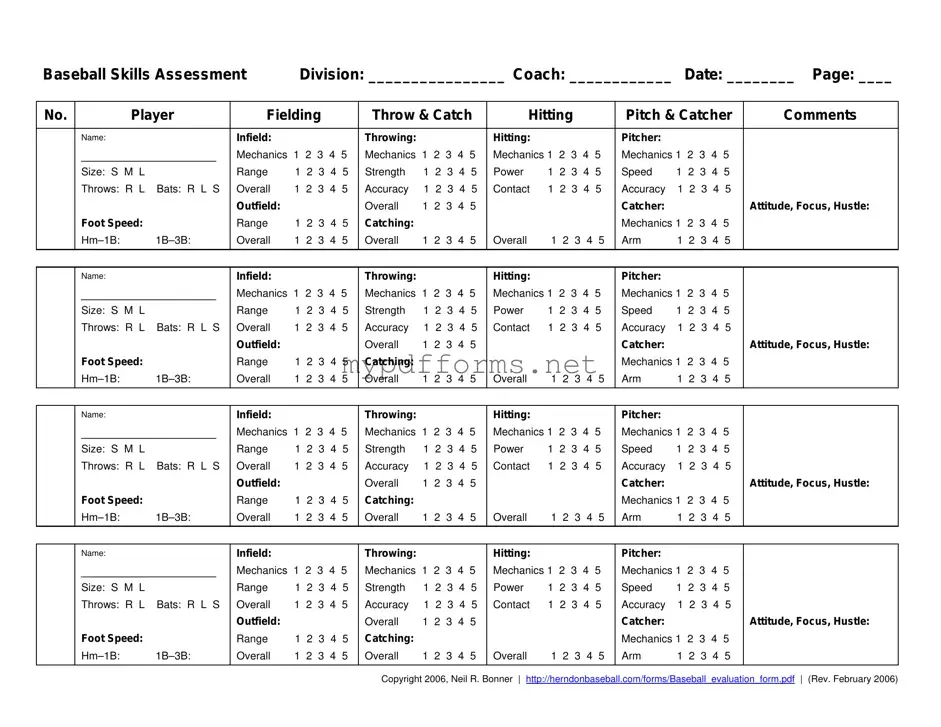The Soccer Skills Assessment form is similar to the Baseball Assessment form in that it provides a structured way to evaluate players based on their skills. Coaches assess players on various aspects such as dribbling, passing, shooting, and defensive skills, using a scoring system that typically ranges from one to five. This allows for a clear comparison of players' abilities, making it easier to select team members for competitive leagues or tournaments.
The Basketball Player Evaluation form shares similarities with the Baseball Assessment form by focusing on a player's performance in key areas. Coaches evaluate skills like shooting, dribbling, passing, and defense, assigning scores based on observed abilities. The structured format helps coaches make informed decisions about team placements, ensuring that players are assessed fairly and consistently.
The Football Skills Assessment form mirrors the Baseball Assessment by providing a comprehensive evaluation of players' abilities. Coaches assess skills such as passing, catching, blocking, and tackling, using a similar scoring system. This structured approach helps identify strengths and weaknesses, guiding coaches in forming balanced teams for games and competitions.
The Softball Skills Assessment form is akin to the Baseball Assessment form, focusing on the essential skills required for the game. Coaches evaluate players on hitting, fielding, and pitching, using a scoring system to quantify performance. This format allows for a clear understanding of each player's capabilities, facilitating fair selection for teams in leagues and tournaments.
The Track and Field Performance Evaluation form also resembles the Baseball Assessment form in its structured approach to assessing athletes. Coaches evaluate runners based on speed, endurance, and technique, using a scoring system that allows for easy comparison among participants. This helps in selecting team members for various events, ensuring that the best athletes are chosen for competition.
The Hockey Skills Assessment form is similar to the Baseball Assessment in that it evaluates players based on key skills such as skating, shooting, and passing. Coaches use a structured scoring system to assess performance levels, which aids in the selection process for teams. This ensures that players are evaluated fairly and that the most skilled individuals are chosen for competitive play.
The Volleyball Skills Evaluation form shares characteristics with the Baseball Assessment form by focusing on essential skills like serving, passing, and hitting. Coaches score players based on their performance in these areas, allowing for a clear assessment of each athlete's abilities. This structured evaluation helps in forming balanced teams and ensuring competitive play.
The Gymnastics Skills Assessment form is similar to the Baseball Assessment form in its focus on evaluating specific skills. Coaches assess athletes on their performance in areas like balance, flexibility, and strength, using a scoring system to quantify their abilities. This structured approach provides a clear picture of each gymnast's strengths and weaknesses, aiding in team selection for competitions.
For those considering the purchase or sale of a motorcycle, it is crucial to utilize the necessary documentation to protect all parties involved. The Illinois Motorcycle Bill of Sale form serves as a key element in this process, ensuring the transfer of ownership is legally recognized. This form provides a comprehensive record of the sale, making it easier for buyers and sellers to finalize the transaction smoothly. To get started, you can find the form through Illinois Forms, which offers easy access to the necessary documentation.
The Swimming Performance Evaluation form resembles the Baseball Assessment by providing a structured method for assessing swimmers' skills. Coaches evaluate athletes based on speed, technique, and endurance, using a scoring system to rank performance. This helps in selecting team members for events, ensuring that the best swimmers are chosen for competition.
